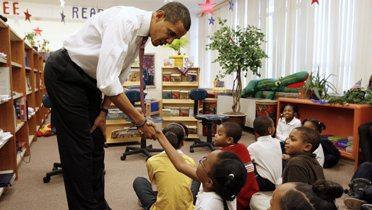In a FY 2011 budget that freezes non-defense discretionary expenditures, the Department of Education has attracted some attention for being one of the few places in the federal government that would attract an increase in funding if the plan is enacted. But the old stuff in the administration’s proposal is at least as interesting as what’s new.
The budget foresees about a $3 billion increase overall for the department, a 6 percent rise over the FY 2010 request. More money for K-12 programs authorized by the Elementary and Secondary Education Act (ESEA), more recently known as No Child Left Behind, accounts for all of this increase, and the administration is signaling that it will put a good deal of energy behind its proposal to strengthen teaching standards as part of a broader ESEA overhaul.
Meanwhile, next year’s budget seeks to build on some of the significant, competitive education programs that were embedded in the stimulus package (ARRA) and are just coming online now. With the first round of state applications for the competitive $4.35 billion Race to the Top (RTT) Fund recently arrived at the department, the budget requests another $1.35 billion to continue the race in FY 2011. States will probably welcome the opportunity to compete for additional federal education funds next year, with their budgets still in crisis, just as the administration would surely relish the opportunity to continue its signature domestic “reform” program. And cash-strapped local governments could jump at the chance, too, as the budget signals that the next round of RTT would make school districts eligible for awards as well.
In the same vein, the budget seeks another $500 million for the Investing in Innovation (I3) Fund, which received $650 million from ARRA. As we’ve written previously here, I3 seeks to experiment with new schooling and instructional models, and to scale up successful practices, through a growing network of educational entrepreneurs in collaboration with local school districts. Applications for the first round will probably be due sometime this spring.
Finally, building on the competition and innovation themes that the ARRA programs exemplify, the budget seeks to streamline existing programs in ways that would give the executive branch new flexibilities. The administration’s proposed ESEA overhaul will seek to consolidate a plethora of narrow, yet often overlapping, programs, many of which originate from its Office of Innovation and Improvement, and eliminate a few more. (Sara Mead and Andy Rotherham called for this sort of shift in approach in a paper they wrote for us laying out a framework for what became the I3 Fund.) Similarly, its Workforce Investment Act (WIA) reauthorization proposal (which I’ll write about in a future post) would consolidate several programs and establish a new joint Labor-Education partnership to administer $260 million in competitive funds.
Big picture, as reported by Seyward Darby, Secretary Duncan earlier this week said, “We’re absolutely philosophically and strategically moving more money, a lot of money, into a competitive basis.”
ARRA clearly laid down an important marker for how the Obama administration intends to use federal education funding to stimulate innovation and drive change. A year on from that emergency program, however, Arne Duncan and company will have some tough battles to wage with a hyper-partisan Congress (which still loves its small formula grants), in the middle of an election year no less, to continue that transformation.
The Brookings Institution is committed to quality, independence, and impact.
We are supported by a diverse array of funders. In line with our values and policies, each Brookings publication represents the sole views of its author(s).






Commentary
Budget 2011: New Funds for the Department of Education?
February 4, 2010